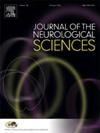血液生物标志物在帕金森病、阿尔茨海默病和额颞叶痴呆中的作用
IF 3.2
3区 医学
Q1 CLINICAL NEUROLOGY
引用次数: 0
摘要
神经退行性疾病的复杂性需要一种结合形态学、功能和分子生物标志物的综合方法。高灵敏度单分子阵列(Simoa®)检测的出现显著提高了血液生物标志物定量的准确性,包括胶质纤维酸性蛋白(GFAP)、神经丝轻链(NfL)和磷酸化tau181 (p-tau181)。本研究评估了这些生物标志物在神经退行性疾病中的诊断效用。我们分析了来自PADUA-CESNE队列的279人的数据:120人患有帕金森病(PD), 88人患有阿尔茨海默病(AD), 16人患有额颞叶痴呆(FTD), 11人患有多系统萎缩(MSA), 14人患有进行性核上性麻痹(PSP),以及30名认知未受损的对照组。与非典型帕金森病和FTD相比,PD和AD患者的NfL水平显著降低,有效地将MSA和PSP与对照组区分开来。NfL与AD和PD的蒙特利尔认知评估(MoCA)得分呈负相关,表明其与认知能力下降有关。在PD和AD患者中均观察到GFAP水平升高,且与整体认知呈负相关。GFAP和p-tau181结合可改善AD与PD和其他帕金森病的区分,而所有三种生物标志物的结合可促进AD和FTD的区分。值得注意的是,较低的NfL水平(20 ng/L)与升高的p-tau181提示AD,而NfL水平低于40 ng/L提示PD。总之,NfL是神经退行性疾病的敏感指标,尽管特异性有限。然而,通过建立生物标志物浓度阈值和整合互补生物标志物,基于血液的检测可以增强神经退行性疾病的鉴别诊断,提供有价值的临床见解。本文章由计算机程序翻译,如有差异,请以英文原文为准。
The role of blood-based biomarkers in Parkinsonian disorders, Alzheimer's disease and frontotemporal dementia
The complexity of neurodegenerative disorders necessitates an integrative approach that incorporates morphological, functional, and molecular biomarkers. The advent of highly sensitive single-molecule array (Simoa®) assays has significantly enhanced the accuracy of blood-based biomarker quantification, including glial fibrillary acidic protein (GFAP), neurofilament light chain (NfL), and phosphorylated tau181 (p-tau181). This study evaluates the diagnostic utility of these biomarkers in neurodegenerative diseases.
We analyzed data from 279 individuals from the PADUA-CESNE cohort: 120 with Parkinson's disease (PD), 88 with Alzheimer's disease (AD), 16 with frontotemporal dementia (FTD), 11 with multiple system atrophy (MSA), 14 with progressive supranuclear palsy (PSP), and 30 cognitively unimpaired controls.
NfL levels were significantly lower in PD and AD compared to atypical parkinsonisms and FTD, effectively distinguishing MSA and PSP from controls. NfL also negatively correlated with Montreal Cognitive Assessment (MoCA) scores in AD and PD, indicating its association with cognitive decline.
Elevated GFAP levels were observed in both PD and AD and inversely correlated with global cognition. Combining GFAP and p-tau181 improved AD differentiation from PD and other parkinsonian disorders, while the integration of all three biomarkers facilitated the distinction between AD and FTD. Notably, lower NfL levels (<20 ng/L) in conjunction with elevated p-tau181 were indicative of AD, whereas NfL levels below 40 ng/L were suggestive of PD.
In conclusion, NfL serves as a sensitive indicator of neurodegeneration, albeit with limited specificity. However, by establishing biomarker concentration thresholds and integrating complementary biomarkers, blood-based assays may enhance the differential diagnosis of neurodegenerative diseases, providing valuable clinical insights.
求助全文
通过发布文献求助,成功后即可免费获取论文全文。
去求助
来源期刊

Journal of the Neurological Sciences
医学-临床神经学
CiteScore
7.60
自引率
2.30%
发文量
313
审稿时长
22 days
期刊介绍:
The Journal of the Neurological Sciences provides a medium for the prompt publication of original articles in neurology and neuroscience from around the world. JNS places special emphasis on articles that: 1) provide guidance to clinicians around the world (Best Practices, Global Neurology); 2) report cutting-edge science related to neurology (Basic and Translational Sciences); 3) educate readers about relevant and practical clinical outcomes in neurology (Outcomes Research); and 4) summarize or editorialize the current state of the literature (Reviews, Commentaries, and Editorials).
JNS accepts most types of manuscripts for consideration including original research papers, short communications, reviews, book reviews, letters to the Editor, opinions and editorials. Topics considered will be from neurology-related fields that are of interest to practicing physicians around the world. Examples include neuromuscular diseases, demyelination, atrophies, dementia, neoplasms, infections, epilepsies, disturbances of consciousness, stroke and cerebral circulation, growth and development, plasticity and intermediary metabolism.
 求助内容:
求助内容: 应助结果提醒方式:
应助结果提醒方式:


